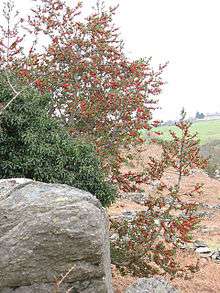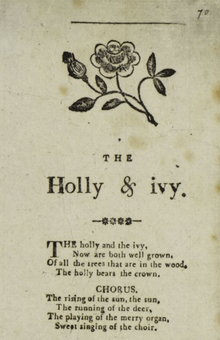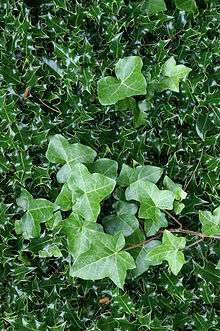The Holly and the Ivy

"The Holly and the Ivy" is a traditional British folk Christmas carol. The song is catalogued as Roud Folk Song Index No. 514. it was adapted into both a play and later film by Wynyard Browne
Words
The following are taken from Sharp's English Folk-Carols (1911), the publication that first established the current words and melody:[1]
- 1
- The holly and the ivy,
- When they are both full grown,
- Of all the trees that are in the wood,
- The holly bears the crown.
- The rising of the sun
- And the running of the deer,
- The playing of the merry organ,
- Sweet singing in the choir.
- 2
- The holly bears a blossom,
- As white as the lily flower,
- And Mary bore sweet Jesus Christ,
- To be our sweet Saviour.
- The rising of the sun, etc.
- 3
- The holly bears a berry,
- As red as any blood,
- And Mary bore sweet Jesus Christ
- For to do us sinners good.
- The rising of the sun, etc.
- 4
- The holly bears a prickle,
- As sharp as any thorn,
- And Mary bore sweet Jesus Christ
- On Christmas Day in the morn.
- The rising of the sun, etc.
- 5
- The holly bears a bark,
- As bitter as any gall,
- And Mary bore sweet Jesus Christ
- For to redeem us all.
- The rising of the sun, etc.
- 6
- The holly and the ivy,
- When they are both full grown,
- Of all the trees that are in the wood,
- The holly bears the crown.
- The rising of the sun, etc.
Origin

The words of the carol occur in three broadsides published in Birmingham in the early nineteenth century.[2][3][4]
An early mention of the carol's title occurs in William Hone's 1823 work Ancient Mysteries Described, which includes "The holly and the ivy, now are both well grown" among an alphabetical list of "Christmas Carols, now annually printed" that were in the author's possession.[5]
The complete words of the carol are found in a book review dating from 1849, in which the reviewer suggested using the text of "The Holly and the Ivy" in place of one of the readings found in the book under discussion.[6] The anonymous reviewer introduced the lyrics of carol thus:
Instead of passages from Bernard Barton, however, and Mary Howitt, we think we could have gathered more from the seventeenth century poets; and especially might larger use have been made of that touchingly simple class of religious ballads, which under the name of carols, &c., is so rife throughout the rural districts, and the humbler quarters of England's great towns. Many of these are only orally preserved, but with a little trouble a large number might be recovered. We have before us at this time a collection of carols printed in the cheapest form, at Birmingham, uniting for the most part extreme simplicity, with distinct doctrinal teaching, a combination which constitutes the excellence of a popular religious literature. From this little volume we will extract one which might well take the place of the passage from Milton for Christmas Day. It is called the "Holly and the Ivy."
The words of the carol were included in Sylvester's 1861 collection A Garland of Christmas Carols where it is claimed to originate from "an old broadside, printed a century and a half since" [i.e. around 1711]:[7] Husk's 1864 Songs of the Nativity also includes the carol, stating:[8]
This carol appears to have nearly escaped the notice of collectors, as it has been reprinted by one alone, who states his copy to have been taken from "an old broadside, printed a century and a half since," i.e. about 1710. It is still retained on the broadsides printed at Birmingham.
Early English Lyrics by Chambers and Sidgwick, published in 1907, repeats Husk's statement.[9]
Variants
| Variant | Wadsworth (1814-1818)[2] | Bloomer (1817-1827)[4] | Wrighton (1812-1830)[3] | The Theologian (1849) [6] | Sylvester (1861) [7] | Husk (1864) [8] |
|---|---|---|---|---|---|---|
| verse 1 line 2: Now are both well grown | X | X | X | X | X | X |
| chorus line 1: The rising of the sun, the sun, | X | |||||
| chorus line 2: |
X | X | X | X | X | X |
| chorus line 3: The playing of the merry groan | X | |||||
| chorus line 4: Sweet singing of the choir |
X | |||||
| chorus line 4: The singing in the choir |
X | X |
Music

The usual melody for the carol was first published in Cecil Sharp's 1911 collection English Folk-Carols.[1] Sharp states that he heard the tune sung by "Mrs. Mary Clayton, at Chipping Camden".[10] Sharp's manuscript transcription of Clayton's singing of the third verse, dated "Jan 13th 1909", is archived in the Cecil Sharp Manuscript Collection at Clare College, Cambridge and viewable online.[11] The melody is notable in being confined to the notes of the hexachord.
 |
The Holly and the Ivy
Tune for The Holly and the Ivy The Holly and the Ivy
Congregational arrangement |
| Problems playing these files? See media help. | |
The early nineteenth-century sources do not provide music for the carol. An 1868 collection of carols coupled the words of "The Holly and The Ivy" to an "old French carol".[12]
Cultural background

Holly and ivy have been a mainstay of British Christmas decoration for church use since at least the fifteenth and sixteenth centuries, when they were mentioned regularly in churchwardens’ accounts (Roud 2004). Holly and ivy also figure in the lyrics of the "Sans Day Carol". The music was first published by Cecil Sharp.[13] Sir Henry Walford Davies wrote a popular choral arrangement that is often performed at the Festival of Nine Lessons and Carols and by choirs around the world.
European Holly[14] was sacred to druids[15] who associated it with the winter solstice, and for Romans, holly was considered the plant of Saturn.[16] European Holly has always traditionally had a strong association with Christmas. Henry VIII wrote a love song Green groweth the holly which alludes to holly and ivy resisting winter blasts and not changing their green hue So I am and ever hath been Unto my lady true.
Hone's 1823 Ancient Mysteries Described, which lists the carol's title as mentioned above, also describes (p 94)[5] a British Museum manuscript: The same volume contains a song on the Holly and the Ivy which I mention because there is an old Carol on the same subject still printed. The MS begins with,
%2C_the_holly_and_the_ivy_-_geograph.org.uk_-_1655707.jpg)
- Nay, my nay, hyt shal not be I wys,
- Let holy hafe the maystry, as the maner ys:
- Holy stond in the hall, faire to behold,
- Ivy stond without the dore, she ys ful sore acold,
- Nay, my nay etc
- Holy and hys mery men, they dawnseyn and they syng,
- Ivy and hur maydyns, they wepen and they wryng.
- Nay, my nay etc'
The Holly and the Ivy is also related to an older carol described by Sharp as: "The Contest of the Ivy and the Holly", a contest between the traditional emblems of woman and man respectively.
- Holly stands in the hall, fair to behold:
- Ivy stands without the door, she is full sore a cold.
- Nay, ivy, nay, it shall not be I wis;
- Let holly have the mastery, as the manner is.
- Holly and his merry men, they dance and they sing,
- Ivy and her maidens, they weep and they wring.
- Nay, ivy, nay, it shall not be I wis;
- Let holly have the mastery, as the manner is.
- Ivy hath chapped fingers, she caught them from the cold,
- So might they all have, aye, that with ivy hold.
- Nay, ivy, nay, it shall not be I wis;
- Let holly have the mastery, as the manner is.
- Holly hath berries red as any rose,
- The forester, the hunter, keep them from the does.
- Nay, ivy, nay, it shall not be I wis;
- Let holly have the mastery, as the manner is.
- Ivy hath berries black as any sloe;
- There come the owl and eat him as she go.
- Nay, ivy, nay, it shall not be I wis;
- Let holly have the mastery, as the manner is.
- Holly hath birds a fair full flock,
- The nightingale, the popinjay, the gentle laverock.
- Nay, ivy, nay, it shall not be I wis;
- Let holly have the mastery, as the manner is.
- Good ivy, what birds hast thou?
- None but the owlet that cries how, how.
- Nay, ivy, nay, it shall not be I wis;
- Let holly have the mastery, as the manner is.
Recorded versions (partial list)
- 1958: Petula Clark for one of the first British stereo releases, on the EP A Christmas Carol
- 1969: The Young Tradition on The Holly Bears the Crown, not released until 1995
- 1972: Steeleye Span, originally as the B-side of the Christmas single Gaudete
- 1982: George Winston (instrumental) on December
- 1985: Yes vocalist Jon Anderson on 3 Ships
- 1986: Choir of St John's College, Cambridge on Christmas Carols from St. John's
- 1987: Maddy Prior with The Carnival Band on A Tapestry of Carols
- 1994: Natalie Cole - "Holly & Ivy"
- 2003: Mediaeval Baebes on their 2003 compilation Mistletoe and Wine and a re-recorded version on the 2013 Christmas album Of Kings And Angels
- 2004: Andrew Peterson Instrumental version on Behold the Lamb of God
- 2008: Kate Rusby on Sweet Bells
- 2010: Annie Lennox on A Christmas Cornucopia
- 2014: Deborah Voigt and the Mormon Tabernacle Choir - Let The Season In
- 2014: Los Campesinos! on their Christmas EP A Los Campesinos! Christmas
References
- 1 2 3 Sharp, Cecil J. (1911). English Folk-Carols. London: Novello.
- 1 2 "The Holly & Ivy". Vaughan Williams Memorial Library.; see also http://www.mustrad.org.uk/articles/birming4.htm
- 1 2 "The Holly & Ivy; Twelve Articles". Bodleian Libraries.
- 1 2 Herald Angels; The Holly & Ivy. Bodleian Libraries.
- 1 2 Hone, William. Ancient mysteries described: especially the English miracle plays, founded on apocryphal New testament story, extant among the unpublished manuscripts in the British museum: including notices of ecclesiastical shows. London: W. Hone. pp. 97–99.
- 1 2 Review of Rivington, Sertum Ecclesiae, the Church's Flowers, from The Theologian and Ecclesiastic vol. vii, January to June 1849, pp. 198-200
- 1 2 Sylvester, Joshua (ed.) (1861). A Garland of Christmas Carols, Ancient and Modern. London: John Camden Hotten. p. 148.
- 1 2 Husk, William Henry (ed.) (1864). Songs of the Nativity. London: John Camden Hotten. p. 85.
- ↑ Chambers, E.K.; Frank Sidgwick (1907). Early English lyrics : amorous, divine, moral & trivial. London: A.H. Bullen. p. 374.
- ↑ Sharp (1911), p. 63
- ↑ "The Holly & the Ivy. Xmas Carol. Mrs. M. A. Clayton at Chipping Camden. Jan 13th 1909" (manuscript facsimile)
- ↑ Warren, Nathan Boughton (1868). The holidays: Christmas, Easter, and Whitsuntide: their social festivities, customs, and carols. Cambridge, MA: Hurd and Houghton. pp. 182–183.
- ↑ The Holly and the Ivy lryics
- ↑ Gaelic: cuileann, Welsh: celyn, Breton:kelen
- ↑ "Pagan Origins of The Holly and the Ivy". Archived from the original on 27 July 2011.
- ↑ http://landscaping.about.com/cs/winterlandscaping1/a/holly_trees.htm
- Steve Roud (2004). A Pocket Guide to Superstitions of the British Isles. Penguin. ISBN 0-14-051549-6.
- Brendan Lehane and the Editors of Time-Life Books (1986). The Book of Christmas (The Enchanted World). Time-Life Books Inc. ISBN 0-8094-5261-8.
External links
- Free sheet music for piano from Cantorion.org
- Hymns Without Words free recording for download suitable for services
- Steve Roud on superstitions
- "Notes on 'The Contest of the Holy and the Ivy'"
- Hymns and Carols of Christmas
- Ancient Mysteries Described Especially the English Miracle Plays, Founded on Apocryphal New Testament Story, Extant Among the Unpublished Manuscripts in the British Museum, Including Notices of Ecclesiastical Shows, the Festivals of Fools and Asses, the English Boy-bishop, the Descent Into Hell, the Lord Mayor's Show, the Guildhall Giants, Christmas Carols, Etc By William Hone, George Cruikshank
- Holly and Ivy Songs